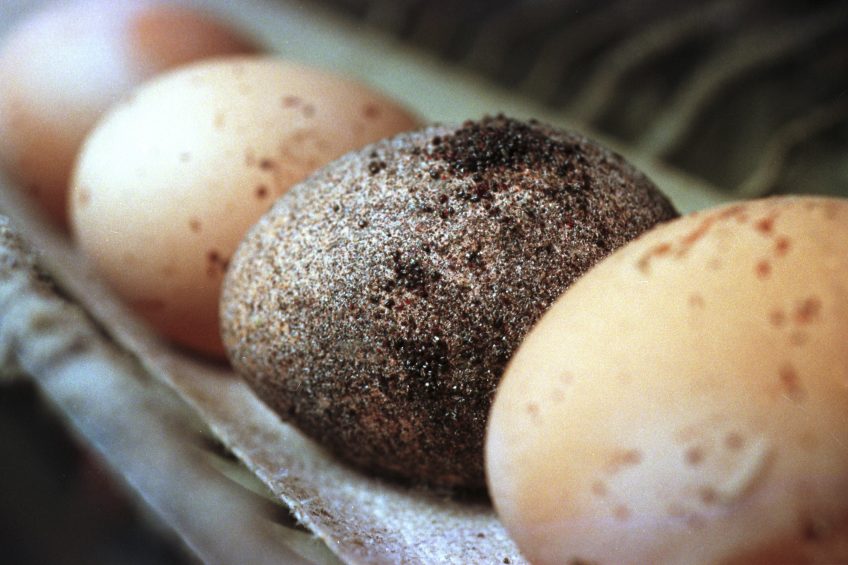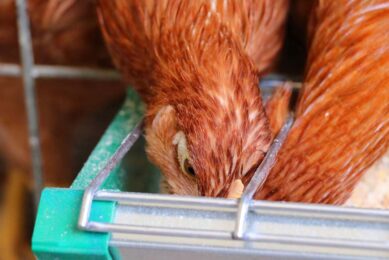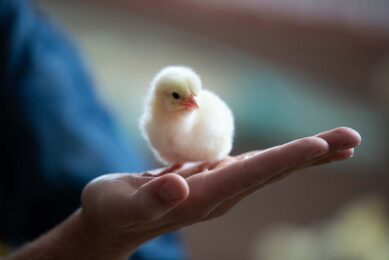The battle against red mites

Controlling red mite is an emerging issue of great significance to the global egg industry. But it is also an underestimated problem by many poultry producers, who aren’t always aware of the full impact of a red mite infestation. Here’s an insight into the consequences.
Poultry farmers who feel alone in their battle against red mite populations in their poultry houses might have one small consolation: nearly every poultry farmer on the planet is dealing with this very issue. “In literature the prevalence is estimated to vary between 80% and 90% in different countries. But in reality this may be closer to 95%,” says Berrian Lammers, poultry veterinarian and red mite specialist at AviVet (Lunteren, the Netherlands). Calling the red mite issue important is an understatement. “Red mites feed on hens at night when they need resting and are producing their eggs.”
Egg quality also affected
Hens suffer enormously from these night-time attacks, as the number of mites could be as high as hundreds of thousands per hen, consuming up to 5% of the hen’s blood in one night. This has a big impact on profitability. It causes stress and fatigue, the lack of rest has a major impact on the immune system. Immune suppression makes the hen more sensitive to diseases such as Salmonella or E.coli. Moreover, it may result in anaemia when the population of red mite is large. Egg quality may also suffer from red mite infestations, as eggs have pale yolks and delicate shells. An increased number of floor eggs is also a sign of red mite infestation, and when a farm suffers from a severe plague, eggs on their way to the packing station can be stained with blood or actual mites. Also increased mortality has been recorded. “But that is not all. Noise levels increase because birds are agitated, and the prevalence of feather pecking and cannibalism goes up,” says Berrian Lammers. “Feed conversion is affected even in early stages when the infestation levels are fairly low.” According to the expert, all these factors together have a significant impact on production and it directly affects profitability. The impact of an average infestation of red mites is economically comparable to a production decrease of 5 to 10 eggs per hen. This results in a serious loss of profit to the farmer.
Welfare issue
To what extent the farmer’s and employees’ health is affected by red mite remains unclear as the issue is reported rarely, but it is clear that some (zoonotic) bacteria and viruses may be transmitted by the bites of red mite. Another aspect that is important enough not to be overlooked is the consumer’s view on animal welfare. Consumers are increasingly focusing on animal welfare issues. “The effect of red mites on the well-being of the hen could become a consumer issue in the future,” adds Lammers. After all, it may start off with just a little itch, followed by increased preening when they are trying to get rid of the mites. Eventually, however, when they fail to eliminate the mites and they can’t handle it anymore, the hens become depressed.
“I also think many poultry farmers are not fully aware of the severity of the red mite problem. And the impact it has on their profit. They ought to be informed about this,” says Roger Gill, head of agriculture at The Lakes Free Range Egg Company Ltd. He thinks veterinarians have a partial responsibility in this, along with feed suppliers. Lammers adds: “Veterinarians should focus more on flock monitoring and the impact of red mites on the health, well-being and productivity of the hens. Although veterinary advice costs money, the impact of the red mite problem is big enough to make a difference.”
Prevention is key
The biggest win can be made in prevention. Preventive measures, improving biosecurity for instance, could the reduce mite population levels on a poultry farm by 60 to 70%. “Good hygiene and biosecurity measures on a farm are extremely important,” says Roger Gill. “Hens can get red mites from wild birds, so there are things we can’t control by taking preventative measures, but good biosecurity goes a long way.” Lammers agrees: “Cleaning boots, boxes and tools, and showering before entering and after leaving the hen house are simple examples of preventative measures that can be taken in order to prevent the proliferation of red mite populations.” Biosecurity plays a key role in preventing the spread between hen houses on a poultry farm. Cleaning the egg belt and the manure belt several times per week can also achieve a big reduction in red mite numbers. And of course pest control is of vital importance, as they can bring red mites onto the farm.

A study revealed that thoroughly cleaning the empty hen house – including the small cracks and crevices of the building – is not a measure all poultry producers take. While this is exactly where mites hide. The European ban on conventional cages and the rise of alternative systems like free-range may increase the red mite issue, as free range systems are favoured by the parasite, due to their many hiding possibilities. And although all production systems are vulnerable, wooden buildings provide mites with more hiding opportunities. Yet, even new sheds, with metal constructions, have angles and corners for populations of red mites to harbour.
Products on the market
Legislation on product use and withdrawal periods vary between countries. “In the Netherlands there are 2 chemical products on the market, with a withdrawal period of 12 hours for regular production and 24 hours for the organic sector which does not make it profitable for use on organic farms,” says Lammers. A method used in newly build houses are perches, with electric wires (Q-perch, Vencomatic, Eersel, the Netherlands). This is an efficient method to decrease mite levels, but not to eliminate them. Apart from conventional treatments like synthetic acaricides and alternative treatments such as biological pesticides and essential oils, predatory mites might be a solution as well. “In France poultry farmers have worked successfully with a combination of two strains of predatory mites: one strain that preferably lives in the litter and chases away the red mites, and one strain of predatory mites which prefers to live inside the system,” says Lammers. Roger Gill adds: “In the past there was some work done on developing a vaccine, but funding is often a problem. Currently there are some researchers working on a vaccine, but it will take time before this will be on the market.”
Check out the interactive Poultry Health Tool – with the latest insights on the 40+ most common poultry diseases.
Proper application
“We sometimes see that poultry farmers aren’t using products correctly,” says Gill. “They know how to use it, but are trying to cut costs and save money by using a lower dose of the product or by diluting it. In those cases it is not the product that doesn’t work properly, but the incorrect application. There is a need to educate farmers about the importance of proper application of products.” Apart from ineffective, there is also danger in developing resistance. Improper treatment application may lead to resistance development. Using a lower dose to cut costs may result in a lack of effective remedies in the long term. It is almost inevitable that resistance to the products is developed in time. Especially when mites are not exposed to a full dose or the treatment level in the bloodstream is not high enough. In that case, some mites are likely to develop resistance and survive the treatment. Therefore, education on the risks of improper treatment application is essential. Another aspect that needs to be taken into account when applying products, is the red mite life cycle and how it relates to treatment protocols.

Monitoring
While it is often quite clear that mites are present in the hen house, estimating the infestation level and timing the right application moment may be challenging. There are 2 validated monitoring devices on the market. These monitoring systems quantify the number of mites present in the house, and when checked every few days it gives a view on how the mite population is changing and moving through the house. “Good tools can give you insight into red mite prevalence, when to treat and what the effect of the treatment is,” says Lammers. In a layer facility with an aviary system the monitors should be placed on the top perches of all rows. Preferably, also monitoring at the lowest cage level should be executed. “The AviVetTM Red Mite trap that we developed has a scientific base and is easy in use. Plus, we currently have developed a software application (AviVetTM Red Mite Monitor), which will speed up the process, as results don’t need to be sent to the laboratory.”

Solution
“Eventually, I think the solution lies in a combination of good education for poultry producers on the severity of the problem and how treatments should be applied,” states Gill. If treatments do not occur at the right time and interval they do not work properly. An interval of 7 to 10 days is required, depending on the cycle. “Automated data collection is important,” Gill emphasises. “This will provide us with more accurate information on the effect of an infestation than when we ask producers in person.” Lammers is unsure whether or not red mites will become a problem of the past at some point. “First we will need to have access to more treatment possibilities to eliminate the mite. Plus, we need to get insight into the severity of the problem. When red mite numbers are fairly low, it is easier to control them with the help of biosecurity and monitoring. Work hygienically, clean boxes and tools, take a shower when entering and leaving the hen house. They are all essential factors. Now, the available treatments are limited, so it is just a matter of time before resistance sets in. Here lies an important task for the sector, veterinarians and international governments. Without it, tackling the red mite issue will remain challenging.”
Also interesting: New water-based red mite treatment ‘99%’ effective
Join 31,000+ subscribers
Subscribe to our newsletter to stay updated about all the need-to-know content in the poultry sector, three times a week. Beheer
Beheer








 WP Admin
WP Admin  Bewerk bericht
Bewerk bericht